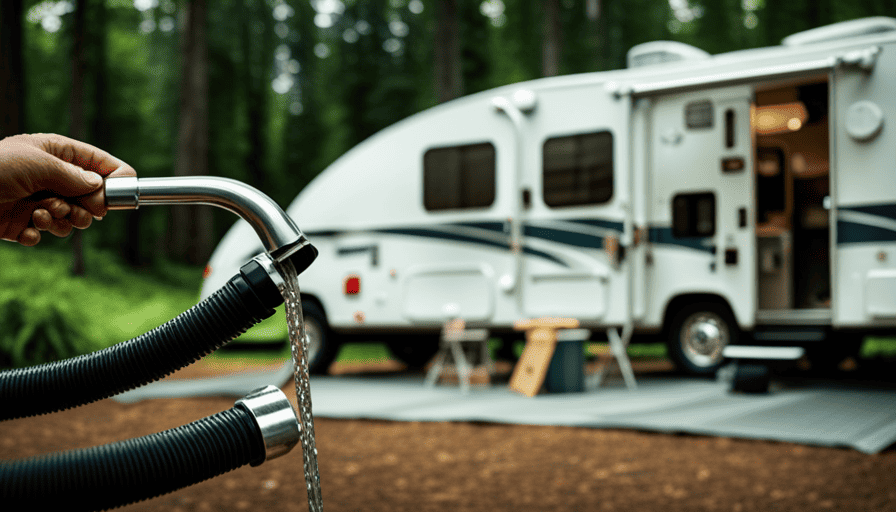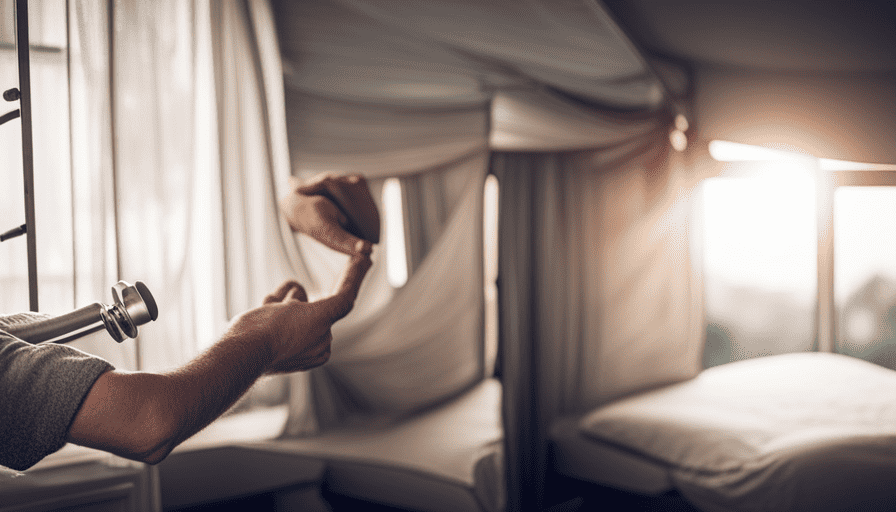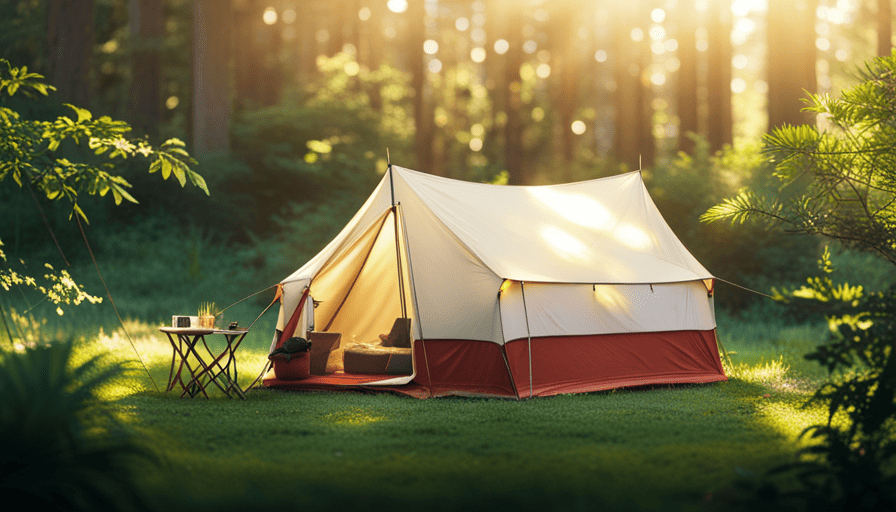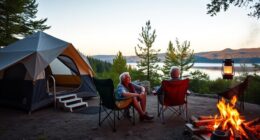Imagine yourself on a camping expedition, reveling in the beauty of nature, when suddenly, a scorching beam of sunlight hits you. The heat rises to unbearable levels, prompting you to seek shelter right away. This is where having an awning on your camper proves to be essential. It provides a shaded retreat, protects you, and sets up a comfortable outdoor space for unwinding and enjoying leisure time.
In this article, I will guide you through the process of installing an awning on your camper, step by step.
To begin, you’ll need the necessary tools and materials, such as a measuring tape, drill, brackets, and awning fabric. Once you’ve gathered everything, we’ll measure and mark the placement of the awning, ensuring the perfect fit. Then, we’ll prepare the camper for installation and securely attach the awning brackets. After that, it’s time to install the awning fabric and roller tube, ensuring smooth operation.
But our journey doesn’t end there. We’ll test the functionality of the awning, ensuring it opens and closes effortlessly. Additionally, I’ll provide tips on cleaning and maintaining the awning, as well as troubleshooting common issues.
So, grab your tools and let’s embark on this awning installation adventure, creating your own shaded oasis on your next camping trip.
Key Takeaways
- Proper measurement and preparation are essential for installing an awning on a camper.
- The choice of durable and weather-resistant fabric is crucial for the longevity of the awning.
- Securely attaching the brackets and correctly adjusting the tension ensures proper functionality of the awning.
- Regular maintenance, including cleaning and troubleshooting, is necessary to keep the awning in good condition.
Gather the Necessary Tools and Materials
Now, you’ll need to gather all the tools and materials you’ll need to install that sleek awning onto your camper, making it the envy of every campsite you roll into.
The first step is choosing the right awning size for your camper. Measure the length and width of your camper’s exterior wall to determine the appropriate size. Take into consideration any obstructions such as windows or doors when selecting the awning size.
Next, it’s important to gather the tools necessary for installation. You’ll need a drill, screws, a level, a measuring tape, a pencil, a ladder, and a helper for safety. Additionally, it’s crucial to have the appropriate materials. This includes the awning fabric, mounting brackets, and any necessary hardware specified by the manufacturer.
Before proceeding with installation, it’s important to understand proper care and maintenance of the awning. This will ensure its longevity and functionality. Regularly clean the awning with mild soap and water, avoiding abrasive cleaners that can damage the fabric. Allow it to fully dry before retracting to prevent mold and mildew growth.
With all the necessary tools and materials in hand, you’re ready to measure and mark the placement of the awning. This will ensure proper alignment and a secure installation.
Measure and Mark the Placement of the Awning
First, make sure to accurately measure and mark the desired location for the awning on your camper. The placement of the awning is crucial to ensure its functionality and aesthetic appeal. Accurate measurements are important because they determine the exact placement of the awning, allowing for proper attachment and functionality.
To achieve this, use a tape measure to measure the width and height of the area where you want to install the awning. Take into consideration any obstructions such as windows or doors that may affect the placement.
Once you have the measurements, mark the placement of the awning using a pencil or chalk. Start by marking the center point of the desired location and then measure and mark the width on each side. This will help ensure that the awning is centered and balanced. Additionally, consider the height at which you want the awning to be installed and mark it accordingly.
To further ensure accuracy, double-check your measurements and markings before proceeding. This will help prevent any mistakes that could lead to an improperly installed awning.
Now that you’ve accurately measured and marked the placement of the awning, you can move on to preparing the camper for installation.
Prepare the Camper for Installation
Before you can start enjoying the shade and protection of your new outdoor oasis, it’s time to get your camper ready for the exciting transformation that awaits. Preparing the camper for installation is crucial to ensure a successful and secure attachment of the awning.
The first step is to check the structural integrity of the camper. Inspect the area where the awning will be attached and make sure it’s sturdy and can support the weight of the awning. Look for any signs of damage or weak spots that may need to be reinforced before proceeding.
Next, remove any obstacles or obstructions that could interfere with the installation process. This includes items such as bike racks, ladders, or any other accessories that may be mounted on the camper’s exterior. Clearing the area will provide a clean and unobstructed surface for attaching the awning brackets.
Once you have checked the structural integrity and removed any obstacles, you’re ready to move on to the next step of the installation process. Attach the awning brackets to the camper, ensuring they’re securely fastened and aligned properly. Now, you’re one step closer to creating your perfect outdoor oasis.
Attach the Awning Brackets to the Camper
Once you’ve ensured the camper’s structural integrity, it’s time to securely fasten the awning brackets, giving your outdoor oasis the perfect foundation to flourish.
When it comes to awning brackets, there are several types available to suit different camper models and designs. Here are three popular options:
-
Standard Brackets: These brackets are the most common and versatile choice. They attach to the camper’s sidewall and provide a sturdy base for the awning.
-
Roof Mount Brackets: If you prefer a sleek and streamlined look, roof mount brackets are a great option. They attach directly to the camper’s roof, eliminating the need for sidewall installation.
-
L-Brackets: These brackets are specifically designed for campers with curved sidewalls. They provide a secure attachment point while accommodating the unique shape of the camper.
To ensure a secure attachment of the awning brackets, follow these tips:
- Use the appropriate hardware provided with the brackets to ensure a strong and reliable connection.
- Double-check that the brackets are aligned properly and level to avoid any stress or strain on the awning mechanism.
- Tighten all screws and bolts securely, but be careful not to overtighten and risk damaging the camper’s structure.
With the awning brackets securely attached, you’re now ready to move on to the next step: installing the awning fabric and roller tube.
Install the Awning Fabric and Roller Tube
Now that the awning brackets are securely attached, it’s time to put on the fabric and roll it onto the tube. Before we begin, it’s important to note that there are alternative awning options available in the market. However, for the purpose of this installation guide, we’ll focus on the traditional fabric awning.
When choosing the right awning fabric, there are a few tips to keep in mind. Firstly, consider the material’s durability and weather resistance. Look for fabrics that are specifically designed for outdoor use and can withstand the elements. Additionally, consider the fabric’s color and pattern, ensuring it complements the overall aesthetic of your camper. Lastly, check the fabric’s maintenance requirements, as some may require more care than others.
To install the awning fabric, start by unrolling it completely on a clean surface. Make sure the fabric is aligned with the roller tube. Begin rolling the fabric onto the tube, ensuring it’s evenly distributed and there are no wrinkles or folds. Use caution to avoid any tears or damage to the fabric during this process.
With the awning fabric securely rolled onto the tube, we can now move on to the next step of securing the awning arms and adjusting the tension.
Secure the Awning Arms and Adjust the Tension
After rolling the fabric onto the tube, it’s crucial to secure the awning arms and make necessary adjustments to ensure optimal tension. This step is essential to ensure the awning functions properly and remains stable during use.
To secure the awning arms, follow these steps:
-
Position the arms: Align the awning arms with the mounting brackets on your camper. Ensure they’re parallel to the ground and extend to the desired length.
-
Lock the arms: Use the locking mechanisms provided to secure the arms in place. This’ll prevent any unwanted movement or collapse while the awning is extended.
-
Adjust the tension: To achieve optimal tension, use the tension knobs located on the arms. Turn them clockwise to increase tension or counterclockwise to decrease tension. Find the right balance that allows the awning to extend smoothly without being too loose or too tight.
By adjusting the awning tension and securing the arms properly, you can enjoy a sturdy and functional awning. Now, it’s time to test the functionality of the awning and ensure everything works as intended.
Test the Functionality of the Awning
To evaluate the awning’s performance, it’s important to test its functionality and ensure it operates smoothly and without any issues.
One interesting statistic to consider is that a well-functioning awning can provide up to 20 square feet of additional shaded area, greatly expanding the usable space of an outdoor living area.
To test the functionality of the awning, start by extending it fully to its maximum length. Observe if the arms move smoothly and if the fabric unfurls evenly without any snags or tangles. Check for any signs of wear or damage on the fabric, such as tears or loose stitching.
Next, retract the awning back into its storage position and make sure it folds properly without any resistance or misalignment.
To ensure the durability of the awning, perform a stress test by gently tugging on the extended fabric to check if it remains securely in place. Additionally, simulate windy conditions by creating airflow near the awning and observe if it remains stable and doesn’t flap excessively.
These awning maintenance tips will help identify any potential issues and ensure the awning is in optimal working condition.
Transitioning into the next section about ‘clean and maintain the awning,’ it is essential to keep the awning in good condition to prolong its lifespan and functionality.
Clean and Maintain the Awning
Taking care of your awning is crucial in preserving its beauty and ensuring it remains a stunning addition to your outdoor space. To maintain your awning properly, follow these awning maintenance tips:
-
Regularly clean your awning to prevent the accumulation of dirt, dust, and debris. Use a soft brush or broom to remove loose particles from the fabric.
-
Use a mild cleaning solution specifically designed for awning fabric. Mix the solution with water and apply it to the awning using a soft sponge or brush. Gently scrub the fabric to remove stains or marks.
-
After cleaning, thoroughly rinse the awning with water to remove any soap residue. Make sure to rinse both the top and underside of the fabric to ensure a complete clean.
Using these awning maintenance tips and cleaning solutions for awning fabric, you can keep your awning looking fresh and vibrant for years to come.
In the next section, we’ll discuss troubleshooting common issues that you may encounter with your awning, ensuring you have the knowledge to address any problems that arise.
Troubleshooting Common Issues
One fascinating statistic to consider is that over 70% of awning-related issues can be resolved by troubleshooting common problems. When installing an awning on your camper, it’s important to be prepared for potential issues that may arise. To help you troubleshoot these common problems, I have provided a table below with some troubleshooting tips.
| Problem | Possible Cause | Solution |
|---|---|---|
| Awning won’t retract | Faulty motor | Check motor connections and replace if necessary |
| Awning fabric is sagging | Loose tension | Adjust the tension using the awning’s adjustment knobs |
| Awning is leaking when it rains | Damaged fabric or seals | Inspect the fabric and seals for any damage and repair or replace as needed |
| Awning is difficult to open or close | Dirt or debris in the tracks | Clean the tracks thoroughly and lubricate with silicone spray |
By following these troubleshooting tips, you can easily resolve common issues with your awning. Once you have addressed any problems, you can enjoy your shaded outdoor space on your next camping trip.
Enjoy Your Shaded Outdoor Space on Your Next Camping Trip
Make the most of your next camping adventure by basking in the cool and shaded outdoor oasis. Installing an awning on your camper not only enhances the overall camping experience but also provides numerous benefits for outdoor activities.
Here are four reasons why having an awning is a must-have for any camping enthusiast:
-
Protection from the elements: An awning offers shelter from the scorching sun, heavy rain, and even a light drizzle, allowing you to enjoy various outdoor activities without worrying about getting wet or sunburned.
-
Extended living space: With an awning, you can expand your camping area and create a comfortable outdoor living space. Set up a cozy seating area, dine al fresco, or simply relax and take in the natural beauty surrounding you.
-
Versatility and convenience: Awnings are designed to be versatile and easy to use. They can be quickly set up or retracted as needed, providing shade or opening up the sky for stargazing.
-
Enhanced privacy: By installing side panels or screens, you can create a private area within your outdoor space, shielding yourself from prying eyes and enjoying a sense of solitude.
By incorporating an awning into your camper setup, you’ll not only enjoy the benefits of camping but also have the perfect shaded spot for all your outdoor activities. So, make the most of your next camping trip and create a cool and comfortable oasis with an awning.
Frequently Asked Questions
How do I choose the right size awning for my camper?
When choosing the right size awning for your camper, there are a few factors to consider. First, measure the length of your camper’s awning rail to determine the appropriate width for your awning.
Next, consider the height of your camper and choose an awning that will provide adequate coverage.
Additionally, think about your specific needs and preferences, such as the amount of shade or privacy you desire.
Taking these factors into account will help you select the perfect awning size for your camper.
Can I install an awning on a camper that already has a roof rack?
Installing an awning on a camper with a pre-existing roof rack is like adding the final touch to a masterpiece. The roof rack compatibility offers a convenient and secure mounting option for your awning.
However, if your camper lacks a roof rack, don’t fret! There are alternative mounting options available, such as using brackets or rails. These options ensure a sturdy and reliable installation, allowing you to enjoy the shade and comfort of your awning wherever you go.
What should I do if the awning fabric tears or gets damaged?
If the awning fabric tears or gets damaged, there are a few steps I recommend taking. First, assess the extent of the damage to determine if it can be repaired or if replacement is necessary.
For minor tears, you can repair the fabric using a patch kit specifically designed for awnings.
If the damage is extensive, you’ll need to find a replacement awning fabric that matches the dimensions and style of your current awning.
Are there any special considerations for installing an awning on a pop-up camper?
Special considerations must be taken into account when installing an awning on a pop-up camper. The lightweight construction of pop-up campers requires a careful approach to prevent damage. Ensure that the awning hardware is compatible with the camper’s structure and weight capacity.
Additionally, consider the size and weight of the awning to avoid overburdening the camper’s frame. Proper installation techniques, such as reinforcement of attachment points, are essential for a secure and durable installation.
Can I install the awning brackets on the side of my camper instead of the roof?
Installing awning brackets on the side of a camper instead of the roof is an alternative awning installation method. It offers both pros and cons.
On the positive side, side installation can provide easier access to the awning and may be more suitable for certain camper designs. However, this method may compromise the structural integrity of the camper and limit the awning’s stability.
It’s crucial to carefully consider the camper’s construction and consult with professionals before opting for side installation.
What Tools and Equipment Do I Need to Install a Power Inverter in a Camper?
To install a power inverter in a camper, you’ll need a few essential tools and equipment. Firstly, gather a power inverter suitable for your camper’s power needs. Besides that, have your hands on the necessary wiring, screwdrivers, electrical tape, wire strippers, and a drill. Make sure to follow safety guidelines and refer to your camper’s manual for specific instructions during the install power inverter camper process.
Conclusion
After following these step-by-step instructions, I successfully installed an awning on my camper. It was a bit challenging at times, but with the right tools and materials, I was able to get it done.
The awning provides the perfect shade for outdoor activities, and it adds a touch of elegance to my camper. I can confidently say that this awning is a game-changer for my camping trips, making them more comfortable and enjoyable than ever before.










